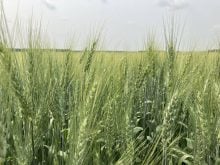As last week’s crop insurance deadlines passed, many farmers tied up their last frantic seeding efforts.
And while some have and might attempt post-deadline seeding, most have put their fields into next year country.
“I think it’s (a situation of ) clean it up and get it ready for next year and get on with life,” said John Duvenaud of theWild Oatsnewsletter and advisory service.
“There will be a little bit of greenfeed, but how many guys can even use greenfeed? Not many commercial grain farmers have any cattle around.”
Read Also

Gap in emission regulations hamstrings Canadian hybrid truck manufacturer
A B.C. company building hybrid engines for heavy trucks says they have the opportunity to build something leading edge in Canada, but our own laws are stopping them from doing it.
The true acreage totals and conditions won’t be known until midsummer. No one believes the numbers in the Statistics Canada seeded acreage report June 23 are close to the reality.
The StatsCan survey was completed in early June, when farmers still hoped fields would dry. Since then conditions have generally worsened.
Farmer’s Edge co-founder Curtis MacKinnon said he had heard farmers trying to seed something to fight weeds, eliminate moisture and produce something of value, even if it was past most insurance deadlines.
“This is one of those years when guys could come up with some innovative ways to deal with it,” said MacKinnon.
“It could even be guys throwing down a kind of green manure crop.”
Cereal crops are generally toughest in the face of bad autumn conditions, which are a likelihood for late-seeded crops. And cereals are generally easy and cheap to grow.
But most observers think farmers spent their last seeding moments trying to get canola planted, because it has the most seeding options in wet conditions, and because it will likely be more profitable.
“You can harrow canola in, you can aerial seed canola in. You can do a lot of things with canola that you can’t with barley or oats,” said Jack Shymko, an Ituna, Sask., farmer and oat industry leader.
“I really think guys did everything they could to get canola in. Even if your canola freezes a little bit and you get a number three, it’s still between $11 and $12 a bushel.”
MacKinnon said farmers hate seeing fields stand empty, so they might try something.
“If they can get out there at all, they might throw some grain in the ground just to have something growing that’s a competitor to weeds and will burn up the moisture,” he said.
Most farmers will just do weed control this summer.
“There’s going to be a lot of chem fallow,” said MacKinnon.
Most farmers know that water with a pH level higher than seven can affect the performance of insecticides, said Jason Deveau, an application technology specialist with the Ontario agriculture ministry.
However, he said only a few producers know how to treat alkaline water so that it’s suitable to mix with pesticides.
“If it’s outside of the (pH) range, what they do about it is where things get a little hairy. Do you try and acidify it? How do you acidify it?” said Deveau, who helped write an article last year for the ministry’s website on water quality and its impact on herbicide and pesticide efficacy.
“That’s the question you get. How do I change the pH of my water without causing some sort of adverse reaction with the product I’m spraying?”
The article’s key recommendation was that farmers know the pH and hardness of water before it goes into the tank because 99 percent of spray solution is water.
Kristen Callow, weed management program lead with the Ontario agriculture ministry who worked on the article with Deveau, said producers should test their water at least once a year.
She said there are three ways to measure pH: a probe and meter, litmus paper or field kit. The probe and meter is the most accurate method and costs around $30.
Individual test strips that come in a kit can test for water hardness.
Deveau said labels on pesticides and herbicides provide information on the ideal pH, hardness and other water quality factors.
High pH and hard water often combine to reduce herbicide effectiveness, but he said farmers should probably ask for advice before taking corrective action.
“A lot of guys know their water pH, but some will be hard pressed to tell you what it means,” he said.
“Some guys will mix incorrectly and they’ll over-acidify, or over-alkalize, and you end up negatively affecting the product.”
Rick Holm, professor emeritus and weed specialist at the University of Saskatchewan, said most producers in Western Canada know that hard water can degrade the effectiveness of some common herbicides.
Holm and his U of S colleagues studied water quality in Saskatchewan in the 1990s and its impact on herbicide efficacy.
“The main issues were hard water with glyphosate and the 2-4-D Amine formulations…. When you add glyphosate to water that have those ions in it, the glyphosate molecule reacts with the calcium and magnesium. Essentially, it inactivates it (glyphosate),” Holm said.
“Also, suspended material in water, silt and organic matter, that would again affect glyphosate and Reglone.”
Farmers have learned to use softer water if it’s available, he said, but where there are no alternatives, most producers have also learned how to treat water with ammonium sulfate, which prevents the calcium and magnesium ions in the hard water from bonding with the glyphosate molecule.
Adding more glyphosate is another option.
“Now it (glyphosate) is incredibly cheap,” Holm said.
“So if you have a water source that is going to reduce the activity of your glyphosate by some degree … sometimes the cheapest alternative is just to put more glyphosate in the tank.”
Holm said little research has been done on the relationship between water quality and herbicide performance since his work on the topic.
However, he is confident that large corporations do their homework on water quality before they release new products into the marketplace.
“There’s been a few new chemistries come along, but there’s no real indication that they’re affected by water quality. There are no red flags going up.”














